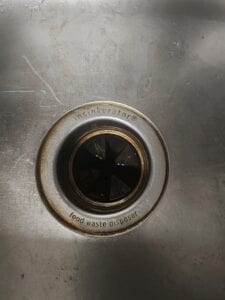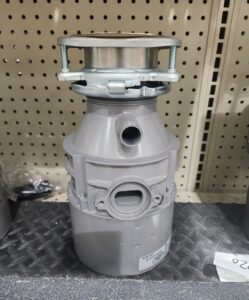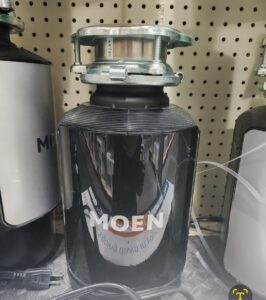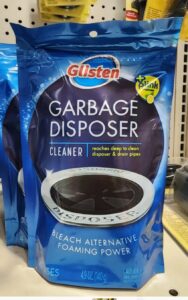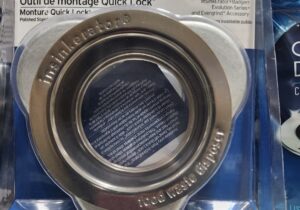Garbage disposals are products that can be installed in your kitchen sink to help dispose of food waste by grinding it up and flushing it down the drain with water. There are two main types of disposals: batch feed and continuous feed. Batch feed disposals require a cover to be placed over the disposal before it can be turned on, while continuous feed disposals can be turned on at any time. In this article Garbage Disposals in a Mobile Home we will discuss everything you need to consider when purchasing one.
Garbage Disposals in a Mobile Home
Waste King and Moen are two popular brands that offer garbage disposal systems with limited warranties and a variety of options to choose from. Waste King offers a range of disposals with powerful motors that can handle tough food waste, while Moen’s disposals come equipped with SoundSHIELD technology to reduce noise during operation.
While using a garbage disposal can help reduce the amount of waste sent to landfills, it is important to note that not all food waste should be disposed of in this manner. For example, grease, oil, bones, and fibrous foods like celery or corn husks should never go down the disposal as they can cause clogs or damage the system.
Do you want to shop the best garbage disposals available. Have these disposals shipped right to your doorstep. These disposals are at unbeatable prices. Shop here now.
Keep Your Mobile Home Garbage Disposal Running Smooth
A study conducted by Safer Choice found that using a tablet to clean your disposal may help keep it running smoothly, but it is not a substitute for proper maintenance and responsible waste disposal practices. To keep your garbage disposal in good working order, you should run cold water while using it and avoid overloading it with too much food waste at once. It’s also a good idea to occasionally grind some ice cubes in the disposal to help sharpen the blades.
In addition to being mindful of what you put down your garbage disposal, you should also consider its impact on the environment. While diverting organic waste from landfills is certainly beneficial, there are still concerns about wastewater treatment facilities being able to handle large amounts of food waste. If your area relies on septic systems rather than municipal sewage treatment plants, using a garbage disposal could actually harm the system.
How Do Garbage Disposals in Mobile Homes Work?
Grind Your Waste with Ease: How Do Garbage Disposals Work?
Garbage disposals are a convenient and eco-friendly way to dispose of food waste. These electrically powered devices grind up food scraps into small particles that can easily pass through plumbing, reducing the amount of waste that ends up in landfills. But how do garbage disposals work? Let’s take a closer look.
The Grind Ring and Impellers
At the heart of every garbage disposal is the grind ring, a stationary metal component with sharp teeth around its perimeter. The impellers, located above the grind ring, are rotating blades that push food waste against the grind ring teeth, shredding and pulverizing it into tiny pieces.
Induction Motors: Garbage Disposals in Mobile Homes
To power the impellers, garbage disposals use an induction motor. This type of motor has coils of wire wrapped around a metal core that creates a magnetic field when electricity passes through it. The magnetic field causes the rotor (the rotating part of the motor) to spin rapidly, turning the impellers and grinding up food waste.
Continuous Feed Garbage Disposals
One popular brand of garbage disposer is InSinkErator. InSinkErator offers continuous feed models that allow users to add waste while the unit is still running. These models typically have a switch or button on the wall near the sink that activates or deactivates power to the unit.
Batch Feed Garbage Disposals
In contrast, batch feed garbage disposers require users to load food waste in batches before turning on the unit. This type of disposer typically has a stopper or lid that fits over the opening where food waste is added. Once filled with food scraps, users turn on power to activate grinding.
Circuit Breakers and Overload Protectors
Garbage disposers typically have circuit breakers or overload protectors built-in as safety features. These devices prevent damage from power surges or overuse by shutting off power to the unit if it becomes overloaded.
Types of Garbage Disposals and Their Features
Continuous Feed vs. Batch Feed: Which Type of Garbage Disposal is Right for You?
One of the first decisions you’ll need to make is whether you want a continuous feed or batch feed model. Continuous feed disposals are the most common type and allow you to continuously dispose of food waste while the unit is running. This makes them convenient for large households or those who frequently cook and generate a lot of food waste.
On the other hand, batch feed disposals require you to load the unit with food waste before turning it on, which can be safer since there’s no chance of accidentally dropping something in while the unit is running. However, they may be less convenient if you’re dealing with a lot of food waste at once.
Additional Features to Consider
In addition to choosing between continuous feed and batch feed models, there are also various features that can impact your decision when selecting a garbage disposal. For example, some models come with sound insulation technology that helps reduce noise levels during operation. If you have an open-concept kitchen or simply prefer quiet appliances, this may be an important feature for you.
Anti-jamming technology is another useful feature that prevents your disposal from getting clogged or jammed up by tough food scraps like bones or fibrous vegetables. Stainless steel components are also desirable since they’re more durable and resistant to corrosion than other materials.
Standard Series vs. High-End Models
Garbage disposals come in different series or tiers based on their price point and included features. Standard series models are typically less expensive and have basic features like continuous feed functionality but lack additional bells and whistles like anti-jamming technology or sound insulation.
Higher-end models offer more advanced features and durability but come at a higher price point. When deciding which series to go with, consider how often you’ll be using your disposal as well as your budget constraints.
Do you want to shop the best garbage disposals available. Have these disposals shipped right to your doorstep. These disposals are at unbeatable prices. Shop here now.
Other Factors to Consider
When selecting a garbage disposal, there are other factors to consider beyond just the type and features of the unit. For example, horsepower is an important consideration since it determines how powerful the unit is and how well it can handle tough food scraps.
Noise level is another factor to keep in mind if you’re sensitive to loud appliances or have an open-concept kitchen. Finally, warranty is an important consideration since it can give you peace of mind knowing that your investment is protected should anything go wrong with your disposal.
Factors to Consider When Choosing: Garbage Disposals in Mobile Homes
Type of Waste: Choosing the Right Horsepower
One of the most important factors to consider when choosing a garbage disposal is the type of waste you will be disposing of. Different types of food waste require different levels of power, measured in horsepower (HP), to effectively break down. For instance, if you frequently dispose of tough ingredients like bones and fibrous vegetables, you’ll need a garbage disposal with higher horsepower to handle them.
Here’s a general guide for choosing the right horsepower based on your needs:
1/3 HP: Suitable for households with light usage and minimal food waste.
1/2 HP: Ideal for households with moderate usage and standard food waste.
3/4 HP: Recommended for households with heavy usage and tougher food waste.
1 HP or more: Best for commercial kitchens or homes that generate large amounts of food waste.
It’s worth noting that higher horsepower models tend to be more expensive upfront, but they can save you money in the long run by reducing clogs, repairs, and replacements.
Size Matters: Choosing a Garbage Disposal That Fits Your Household
Another crucial factor to consider is the size of your household and the amount of waste generated. A larger household will likely generate more food waste than a smaller one, so it’s important to choose a garbage disposal that can keep up with your needs.
In addition to considering how much food waste you produce, think about how often you plan on using your garbage disposal. If you’re someone who cooks frequently at home and generates a lot of scraps, you may want to invest in a larger model that can handle heavier loads without getting clogged.
Products like listed below can help if you have clogs in your garbage disposal.
On the other hand, if you live alone or don’t generate much food waste, a smaller model may be sufficient for your needs. It’s all about finding the right balance between power and capacity based on your unique situation.
Quiet Please! Noise Reduction Features
Garbage disposals can be noisy, which can be a problem if you have a small home or live in close quarters with others. Fortunately, many modern garbage disposals come equipped with noise-reducing features to minimize disruption.
Look for models that use insulation or sound-dampening materials to reduce noise levels. Some models also come with anti-vibration mounts that help to absorb sound and prevent the disposal from rattling around under your sink.
Durability Matters: Choosing High-Quality Materials
A garbage disposal is an investment, so it’s important to choose one that will last for years to come. Look for models made with high-quality materials like stainless steel and corrosion-resistant alloys that can withstand heavy usage and tough ingredients.
It’s also worth considering the warranty offered by the manufacturer. A longer warranty period indicates that the manufacturer has confidence in their product’s durability and is willing to stand behind it.
Price vs Quality: Finding the Right Balance
Price is always a consideration. While it may be tempting to opt for a cheaper model, keep in mind that investing in a higher-quality model can save you money in the long run by reducing repairs and replacements.
That said, there are plenty of affordable options on the market that offer solid performance and durability. It all comes down to finding the right balance between price and quality based on your needs and budget.
You might also be interested in our article Are Mobile Homes Safe?
Installing a Garbage Disposal Unit: A Step-by-Step Guide
Basic Plumbing Skills and Tools for Installing a Garbage Disposal Unit
Installing a garbage disposal unit is an excellent way to make your kitchen more convenient and efficient. However, it requires basic plumbing skills and tools. If you’re comfortable with DIY projects, you can install the unit yourself by following these steps.
Before Installation: Check Your Septic System
Before installing a garbage disposal unit, it’s essential to check whether your septic system can handle it. A septic system that is not designed to handle food waste may become clogged, leading to costly repairs. You should also check local building codes to ensure that installing a garbage disposal unit is permitted in your area.
Its also important to have the right locks on your mobile home garbage disposal to make sure it fits well.
Feed Models for Garbage Disposal Units
There are two types of feed models for garbage disposal units: batch feed and continuous feed. Batch feed models require you to load the food waste into the chamber before grinding it up. Continuous feed models allow you to add food waste while the unit is running.
Horsepower Range of Standard Garbage Disposal Units in the United States
In the United States, standard garbage disposal units have a horsepower range of 1/3 to 1 horsepower. The higher the horsepower rating, the more powerful the unit will be at grinding up food waste.
Popular Brands of Garbage Disposal Units
Some popular brands of garbage disposal units include InSinkErator’s Prep Series and Waste King units. These brands offer high-quality products that are reliable and efficient.
How to Install a Mobile Home Garbage Disposal Unit in a Double Sink
If you have a double sink, installing a garbage disposal unit can be slightly more complicated than with a single sink. However, it’s still possible with some additional steps:
Disconnect both sinks from their plumbing connections.
Connect one side of the sink’s drain pipe directly to the garbage disposal.
Run another pipe from the other side of the sink into an inlet on top of your garbage disposal unit.
Connect the garbage disposal to the drainpipe that leads to your septic or sewer system.
Who Can Install a Garbage Disposal?
If you’re not comfortable installing a garbage disposal unit yourself, you can hire a plumber or handyman. They will have the necessary tools and experience to install the unit safely and efficiently.
You might be interested in our article Why is My Ceiling Cracking?
When installing a garbage disposal in a double sink, it’s essential to place it on the side with the dishwasher drain. This placement ensures that food waste from the dishwasher is ground up before being flushed down the drain.
Maintaining Your Garbage Disposal: Tips for Cleaning and Troubleshooting Common Issues
Regularly Cleaning Your Garbage Disposal
It’s important to clean your garbage disposal regularly to prevent buildup and keep it running smoothly. One easy way to do this is by pouring a mixture of ice cubes and rock salt down the drain, followed by cold water. The ice helps to dislodge any debris that may be stuck in the blades, while the rock salt helps to eliminate any odors.
Another method for freshening up your garbage disposal is by using citrus peels or vinegar. Simply toss some lemon or orange peels down the drain and turn on the disposal, or pour a cup of vinegar down the drain and let it sit for 30 minutes before rinsing with cold water. This will help to eliminate any bacteria that may be causing unpleasant smells.
Avoiding Common Issues
To prevent clogs and damage, it’s important to avoid putting non-food items, fibrous foods, and grease down your garbage disposal. Non-food items such as plastic or metal can damage the blades and motor, while fibrous foods like celery or corn husks can get tangled around the blades and cause clogs. Grease should also be avoided as it can solidify in your pipes over time, leading to blockages.
If you do encounter a clog in your garbage disposal, try using a plunger or plumbing snake to remove it. It’s important not to use chemical drain cleaners as these can damage your pipes over time.
Troubleshooting Common Issues
If your garbage disposal isn’t working properly, there are a few troubleshooting steps you can take before calling in a professional plumber. First, check if there is power going to the unit by pressing the reset button located at the bottom of the unit. If this doesn’t work, check if there is anything blocking the blades by turning off power at the circuit breaker and using tongs or pliers to remove any debris.
If you hear strange noises coming from your garbage disposal, this could indicate a more serious issue. It’s best to call in a professional plumber to diagnose and fix the problem to avoid further damage.
Noise Level, Durability, and Horsepower: Comparing Different Types of Garbage Disposals
Horsepower: The Key to Efficient and Powerful Garbage Disposals
Horsepower is a crucial factor to consider. A higher horsepower means more grinding power and the ability to handle tougher food waste. In general, garbage disposals come in three different horsepower ratings: 1/3 hp, 1/2 hp, and 1 hp.
If you have a smaller household with less frequent use of the disposal, a 1/3 or 1/2 hp model may suffice. However, for larger households or those who frequently use their disposal for tougher food waste such as bones or fibrous vegetables, a 1 hp continuous feed model is recommended.
In addition to better performance, higher horsepower models tend to be more durable than lower horsepower ones. This is because they are built with stronger components that can withstand the pressure and wear-and-tear of heavy usage over time.
Sound Reduction: Keep Your Kitchen Quiet with Sound Insulation Technology
Garbage disposals can be noisy during operation, which can be disruptive in an open-plan kitchen or when cooking late at night. Fortunately, many manufacturers now offer sound insulation technology or quiet series models that significantly reduce noise levels during operation.
Sound insulation technology involves adding layers of sound-absorbing materials around the motor and grinding chamber of the unit. Quiet series models typically feature rubber mounts that dampen vibration and reduce noise levels even further.
Stainless Steel Components: The Key to Durability and Corrosion Resistance
Stainless steel is a popular material used in garbage disposals due to its durability and resistance to corrosion. Models with stainless steel components are less likely to rust or wear out over time compared to those made from other materials such as galvanized steel.
When choosing a garbage disposal, look for models with stainless steel grinding chambers and cutting blades for maximum durability. Some units also feature stainless steel splash guards that prevent food waste from splashing out during operation.
Power Cord: Check Before You Buy
Some garbage disposals come with a power cord included, while others require a separate purchase. It’s important to check whether a power cord is included before purchasing a unit to avoid any unexpected additional costs.
Pressure: The Key to Efficient Grinding Performance
The pressure created by the metal components of a garbage disposal can affect its overall performance and durability. Choosing a model with high-quality metal components such as stainless steel can ensure long-lasting performance.
How to Choose the Right Size of Garbage Disposal
Determining the Right Size of Garbage Disposal
There are several factors you need to consider. A garbage disposal is a convenient appliance that can help reduce food waste and keep your kitchen clean. However, choosing the wrong size can lead to problems such as clogging and inefficiency. In this section, we’ll discuss some key points to help you determine the right size of garbage disposal for your household.
Amount of Food Waste Produced
The amount of food waste produced in your household is one of the most important factors to consider when choosing a garbage disposal. If you have a large family or frequently entertain guests, you may need a larger unit that can handle more waste. On the other hand, if you live alone or with just one other person, a smaller unit may be sufficient.
Horsepower
Garbage disposals come in different horsepower ratings, ranging from 1/3 HP to 1 HP or more. The higher the horsepower rating, the more powerful the unit will be and the better it will be able to grind tougher food waste such as bones and fibrous vegetables. For most households, a 1/2 to 1 horsepower model is recommended.
Dimensions
Before purchasing a garbage disposal, make sure to measure the space under your sink where it will be installed. You’ll want to ensure that there is enough room for both the unit itself and any additional components such as mounting hardware and electrical wiring. It’s also important to consider the height of the unit and whether it will interfere with any plumbing or wiring.
Noise Reduction Features
If noise is a concern for you, look for a garbage disposal with noise reduction features such as sound insulation or anti-vibration mounts. These features can help reduce noise levels during operation and make your kitchen quieter overall.
Mobile Home Garbage Disposal Warranty
Finally, consider the warranty when choosing a garbage disposal. A longer warranty can provide peace of mind and protect your investment. Look for a unit with at least a 2-year warranty, although some models come with warranties of up to 10 years.
Environmental Impact of Garbage Disposals
Garbage disposals are commonly used in households to dispose of food waste. While they may seem like a convenient solution, they have a significant impact on the environment. In this section, we will discuss the environmental impact of garbage disposals and how it can be mitigated.
Contribution to Food Waste and Solid Waste
Garbage disposals contribute to the increase in food waste and solid waste in landfills. When food scraps are sent down the disposal unit, they end up in landfills where they produce methane gas, a potent greenhouse gas that contributes to climate change. Garbage disposals can lead to clogged pipes and wastewater treatment issues due to their inability to break down certain types of food waste. This results in an increased amount of solid waste that ends up in landfills.
Wastewater Treatment Issues
When food scraps are sent down the disposal unit, it can cause wastewater treatment issues. The high concentration of organic matter from the food waste can overload wastewater treatment plants and cause them to malfunction. This leads to untreated wastewater being released into waterways which can harm aquatic life and contaminate drinking water sources.
Composting as an Alternative
The environmental impact of garbage disposals can be reduced by composting food waste instead. Composting is a natural process that breaks down organic matter into nutrient-rich soil that can be used for gardening or farming. By composting food waste, it reduces the amount of solid waste that ends up in landfills while also producing a valuable resource.
Waste Reduction Practices
Waste reduction practices such as reducing overall consumption, reusing items instead of disposing of them, and recycling materials can also help mitigate the negative impact of garbage disposals on the environment. By reducing overall consumption, less waste is produced which means less ends up in landfills or wastewater treatment plants.
Choosing Not To Use Garbage Disposals
Choosing not to use a garbage disposal can also be an effective way to reduce one’s environmental footprint. Instead, food scraps can be collected and composted or disposed of in the trash. This reduces the amount of solid waste that ends up in landfills and wastewater treatment plants.
The Importance of Proper Use and Maintenance of Garbage Disposals
Proper use and maintenance of garbage disposals are essential for keeping your kitchen clean, functional, and eco-friendly. Garbage disposals are convenient appliances that can help you get rid of food waste quickly and easily. However, they require proper handling to avoid clogging, jamming, malfunctioning, or damaging the environment.
By understanding how garbage disposals work and selecting the right type and size for your needs, you can save time, money, and energy while reducing your carbon footprint. Installing a garbage disposal unit may seem daunting at first glance but with our step-by-step guide, you can do it yourself without any hassle.
To keep your garbage disposal in top shape, regular cleaning is crucial. You can follow our tips for maintaining your garbage disposal to prevent odors, bacteria growth, and other issues that may affect its performance. Moreover, by being mindful of what you put into your disposal unit – avoiding hard items like bones or fibrous materials like celery – you can prolong its lifespan.
Garbage Disposals in Mobile Home: Conclusion
When choosing a garbage disposal unit to purchase or install in your kitchen sink, there are several factors to consider such as noise level, durability and horsepower. Each type has unique features that suit different needs so it’s important to choose the one that fits yours best.
FAQ’s: Garbage Disposals in Mobile Homes
What is the downside to garbage disposal?
A downside to garbage disposals is that they can contribute to clogs and blockages in plumbing if not used properly or if inappropriate items are disposed of. They can also consume electricity and water, which may increase utility costs.
What do plumbers think of garbage disposals?
Plumbers have mixed opinions on garbage disposals. Some see them as a convenient kitchen appliance, while others view them as potential sources of plumbing issues. It’s important to use disposals responsibly, avoiding putting items like grease or large food scraps down the drain, to prevent plumbing problems.
Should I get rid of my garbage disposal?
Whether to keep or remove your garbage disposal depends on your specific needs and preferences. If used correctly, disposals can be useful, but if you frequently encounter plumbing issues or prefer to compost kitchen waste, you may consider removing it.
Where does a garbage disposal drain?
A garbage disposal typically drains into your home’s sewer system or septic tank, depending on your plumbing setup. It grinds up food waste and sends it down the drain, where it then travels to the municipal sewage system or your septic system for processing.
You might also be interested in our articles:



